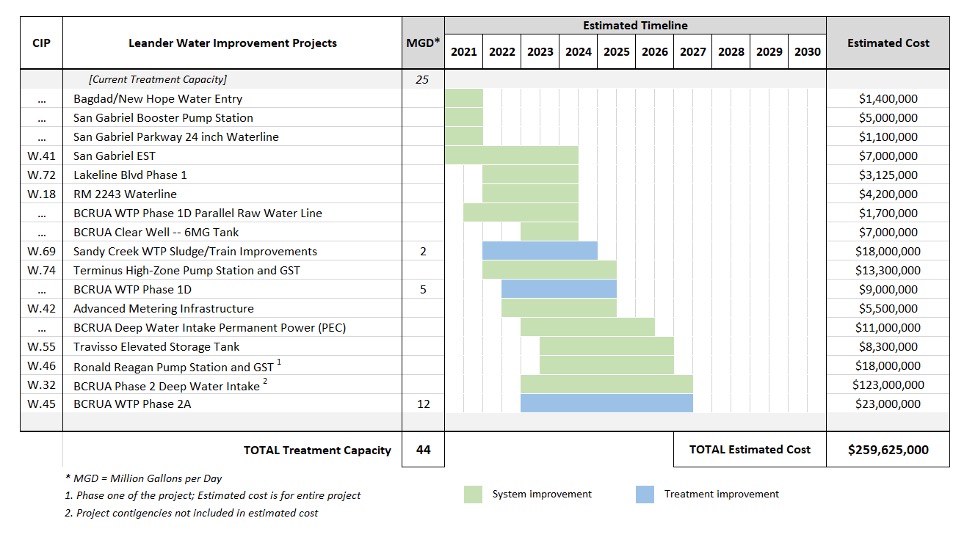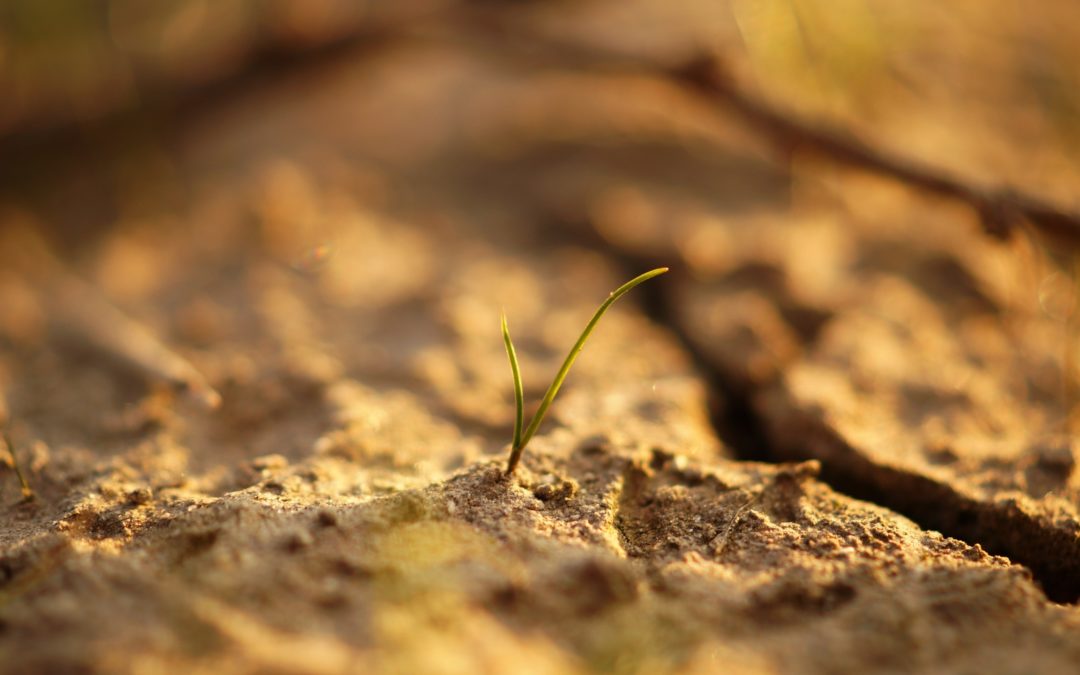If you’ve come here looking to learn about Leander’s current water issues, you probably first checked the date on this post. Leander has been plagued with water issues since the city’s inception and truthfully, we’ll continue to have issues for a few more years. The good news is there’s light at the end of the tunnel and we’re finally on the right and responsible path. The bad news is improvements take time and patience – they cannot happen overnight.
I realize though that we, as a city, have never done a great job of communicating in one place what the issues are and what everyone can expect. So I’m going to address it all here for you today – a reference point that you can bookmark and share and know what the story is. Grab your popcorn, we’re going to be here a while.
Let’s start with the history of the water treatment plants
Leander has two plants to treat water: The first is Sandy Creek, a tiny plant that is all our own. The second is the BCRUA plant which we share ownership of with the cities of Round Rock and Cedar Park.
Sandy Creek’s story begins in 2000, when then-mayor Charles Eaton and city staff coordinated a campaign with the Brazos River Authority (BRA) to move legislation to allow for inter-basin transfer – basically moving water from the Brazos River Authority’s area to the LCRA area for treatment and distribution. The legislation passed and so LCRA built the Sandy Creek plant in 2001 to serve Leander. It was run by the BRA and had an itty bitty capacity of just 4 million gallons per day.
The LCRA at that time had LOTS of water treatment plants in Central Texas, but running a water treatment plant is expensive and they were losing money on them. LCRA decided to exit the water treatment business and sell their plants. The original plan was to sell all the plants to a single private buyer who, in turn, would treat and sell water to all the cities who were already customers of this plant. That’s well and good for LCRA because it offloads all the plants at once, but a horrible deal for the water users who are then beholden to a single provider who can determine what they pay. Leander and a handful of other cities formed a small coalition to push LCRA to change tracks and instead sell off the plants to the cities who needed them. Leander was one of the first to be successful and we purchased the Sandy Creek plant in 2011.
During all that time from 2000 – 2011, we knew we were going to need more water. The LCRA expanded Sandy Creek twice, so by the time of sale, it had upgraded from the original 4 million gallons per day to 12 million gallons per day, which was great, but we knew we would need even more than that. So talks began with the cities of Cedar Park and Round Rock to form the Brushy Creek Regional Water Authority (BCRUA) which would create an enormous water treatment plant where the costs of construction and operations could be shared so as not to bankrupt any single city.
It’s important to the story to note here that at the inception of the BCRUA, Leander knew and was open about the fact that BCRUA was going to be our primary water source. Sandy Creek is a great plant, but there isn’t room for significant expansion. Building a third plant doesn’t make any sense when we can just buy into the lions share of the BCRUA and secure a larger amount of treated water through that plant. This is not the case for either of the other two entities – Round Rock and Cedar Park were both growing significantly before Leander was and already had large water treatment plants of their own. BCRUA is a secondary source to each of them. This is why when things happen at BCRUA, it hits Leander harder than the other two cities.
So, back to BCRUA – The ginormous plant was a significant cost to build and with all the cities still growing and anticipating many decades of growth, the plan was made to build the plant in phases. While some parts of Phase One were meant to be the core of the plant, other parts were meant to be temporary and replaced in later phases. Phase One opened in July of 2012 and all the water trouble for the region was resolved, everyone was satisfied, and the residents celebrated by running all their faucets non-stop for decades.
Just kidding. The new construction was plagued with problems from the moment it opened. The process for government lawsuits is long and arduous and there aren’t a lot of publicly available records on the faults and what happened, but if you doubt that there were issues that needed mitigating back in 2012, you can review this article from the Statesman in 2013, this video of the BCRUA voting on a supplemental agreement for services for additional work necessary to finish repairs and defect work ongoing at the plant, with references made toward mediation and settlement, and this copy of the meeting minutes from 2019 where a settlement offer was accepted.
This was all before the big pipeline break in 2020. Until that break, (my understanding is) the issues were believed to have been only in the plant itself, not the pipeline.
So what about the pipeline?
THE pipeline. The infamous pipeline that has plagued us the last few years. That pipeline was supposed to be temporary. It was always supposed to be temporary. Since the opening of the BCRUA plant, the raw water has been pumped out of the lake using a floating barge connected to a pipeline that runs along the lakebed. A floating barge isn’t uncommon for pulling water, but the full buildout of BCRUA is going to require more power than you can get from a barge. Plus, since Texas is prone to drought, putting a permanent intake deep into the lake drought-proofs our water supply. It’s a win-win. The deep water intake project not only removes the barge, but also puts that water line underground.
When the pipeline burst in late 2020, it revealed structural problems that weren’t known previously. Apparently there were some changes in plans right in the middle of construction and so the pipeline was changed midway through. Additionally, there was deflection in the pipe caused by settling of the pylons on the lakebed – this should have never happened. The BCRUA is still in the process of rectifying all that damage, but remember what I said earlier about the first go-round on structural problems? Those problems were identified in 2012 and the settlement made it to the agenda in 2019.
That first time the pipe broke in 2020, it was catastrophic. Incredible, specialized parts and equipment had to be ordered. Crews had to be brought in. The pipeline couldn’t work until everything came together and was in place. That’s why we had problems for such a long time. We learned though. Realizing that the pipeline could be problematic, BCRUA put a bunch of repair parts on the shelf, in storage, in case another issue popped up. They also learned to send divers down every few weeks to inspect the pipeline to look for problems before they become catastrophic.
When the pipeline was shut down in the fall of last year, it was because a small leak was found on one of the diving inspections. By catching the leak early, the BCRUA was able to prevent the pipeline from blowing out and prepare for a comprehensive repair. That repair was massive and increased the strength of a long section of the pipeline. Unfortunately, a few months ago, the pipeline broke (again) where the new parts connected to the old parts. Every time the pipeline needs a repair, we need to have users restrict their watering.
Our problems are not just the pipeline though.
This is the part where we have a little reckoning. Some of the blame on our water issues lands squarely on us and the decisions the city made in the past. We didn’t do a good job in tracking usage and growth and making sure we had the capacity to meet demand. In 2016, the city council voted approval of a resolution against the deep water intake at that time. They were so adamant, every member of council signed it. And honestly, electing people who feel like the BCRUA is a bad deal, but didn’t offer any alternative, didn’t signal a willingness to work with our city partners.
But the worst thing, by far, is that we’ve entered into contracts selling our water. It started with Liberty Hill more than a decade ago and it worked out fine. But in 2020, the council voted 4-3 in favor of selling 3 million gallons of water a day to the City of Georgetown for 7 years. That’s 3 million gallons contractually obligated and at a rate less than what you see on your water bill. It’s Item 22 on these minutes and it’s been hailed by our current staff as the worst thing to ever happen to Leander water.
It’s not Georgetown’s fault. They asked and we readily sold it. This is on us.
What happened this time?
This time, it wasn’t the pipeline at fault. On Thursday, some of the pumps malfunctioned and the BCRUA asked cities to lower their water usage. Leander complied. We had some slow filling of our tanks, but overall, we’ve been OK. And BCRUA is saying they’re back up to full capacity, but out of an abundance of caution, we’re going to verify that for ourselves before we give a false all-clear. We have a public works update on water at this Thursday’s council meeting and we’ll be able to fully publicly address the concerns of our residents.
So how are we fixing our problems?
This is where we get to the good news. Never before has the city of Leander moved so quickly on water projects. The volume of projects in a condensed amount of time is ambitious, but we are 100% committed and all the projects are moving along. We have worked with our BCRUA partners to push through several expansions of the plant. We’re also expanding the processing capabilities at our Sandy Creek Plant. Purple Pipe (reuse) was started when the Travisso neighborhood was built and extended to our golf course, and we’re creating a second system now around Horizon Lake and Northline. The image below shows the timeline of all the projects we’re working on. In addition, we’ve hired a conservation coordinator that helps residents with optimizing their irrigation systems and has introduced a rain barrel purchase program.

On top of all these projects, Williamson County dedicated ARPA funding to BCRUA to install a parallel raw water line to temporarily replace that problematic temporary line. We expect that to be online in less than a year (Thanks Williamson County!).
Why don’t we just stop allowing all this construction?
Because the state of Texas doesn’t allow us to. The state requires that we need to be fully out of water before we can issue a moratorium. Since we can’t do that, we’ve done what we can legally do – we’ve made it a little harder to build here. We’ve increased fees builders pay to help us with the costs of all the residents coming here. We changed our development codes to require less landscaping. We’re about to talk about increasing parkland dedication fees. We’ve instituted phasing of large projects to keep big neighborhoods from popping up all at once, and we approved a resolution against increasing density on rezoning requests. We also gave a future neighborhood to another city, giving up that tax base, in exchange for the other city carrying the burden of their water service.
If you want to know more about moratoriums and the difficulty of enacting them, I wrote about it in detail previously.
So what can Leander water customers expect for the next few years?
Conservation. Of course we want everyone to conserve whenever possible, but these extra efforts and conservation phases are going to pop up from time to time. It doesn’t mean we aren’t progressing. We’re going to have trouble here and there until 2027, which is when everything is online and our water problems are fully behind us. This is as fast as these projects can move and anyone who tells you otherwise doesn’t live in reality.
Our goal is to keep using the conservation phases in order to prevent a boil water notice. Remember those? We haven’t had one in a few years. When there’s decreased water in the system and in the water towers, the system loses pressure. When that happens, samples of water from all over the system have to be sent to TCEQ to be tested and TCEQ has to approve that the water is safe before the boil water notice can be lifted. The larger the area that’s lost pressure, the longer the turnaround time from TCEQ is going to be. When we’re asking you to not run your irrigation system, we’re just asking you to keep the pressure in the line so we don’t get to the boil water notice. So far, it’s working and we are beyond appreciative of everyone’s efforts.
I want you to know too, that this isn’t just a Leander issue. This is a Texas issue. I’m comfortable because we’re future-proofing our system. Many, many municipalities are not and many right here in Williamson County don’t have their own water treatment facility at all and are far from any real water supply. It’s such a large issue that the state’s own Water Development Board has issued forecast that the state will be in a massive deficit by 2070. I fully believe that over the next 10 years, with all of the population growth in the state, we’re going to see more and more focus on the need for water conservation.
I know this is all frustrating, but I want you to know that we truly are making progress. It’s not behind us yet, but we are steadily in a better and better position over the last 2 years. Thank you for conserving and staying informed. You are appreciated.
All the best,



Require builders to use Conservation Design. See Randall Arendt’s work. Require builders to use the native grasses, already there and not scrape up the native grasses, put them in the landfill and put in sprinklers and new, non-native grass. At least for roadsides, common areas. Ditto for trees and shrubs. Why not encourage rainwater collection by getting rid of permit fees for residents? Require rainwater collection and HVAC condensate lines going to them for every NEW home.
What progress have we made with allowing ALL Leander to put in artificial turf? Travisso currently is denying requests. This is ridiculous if we will continually be facing these issues. My neighbor and I would love to have this, but cannot. Think of all the water we would be saving.
The problem with turf grass is that it alters the way water flows. It’s typically non-absorbent, so if you end up with enough of it, it throws off the calculations that were made when planning drainage and can lead to flooding. A better option is xeriscaping.
Thank you, Mayor Christine, for the extensive details and history of our water systems. Conservation is certainly key for the future. How does to city encourage low water landscaping? Removing lawn grass, which is a water hog, is expensive once it takes root. How doe we incentivize current and future homeowners and home builders to invest in water smart landscaping?
Thank you for taking the time to explain all of this in one place. Very informative and I greatly appreciate it!
Been here 7 years and you’ve done a great job of communicating with us here in Leander. Can’t say that for predecessors. Appreciate your commentary very much.
Moratoriums are possible, it was done in the 80s due to WW capacity. It seems development will always rule the decisions made. Sadly.
Also suggest a moratorium on new swimming pools as part of the water conservation effort.
Honestly, communication like this is why I’ll vote for her next time. Thank you, from the bottom of my heart for not treating us like four year olds, and giving us the nitty gritty.